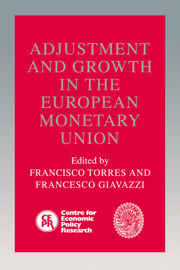Book contents
- Frontmatter
- Contents
- List of figures
- List of tables
- Preface
- List of contributors
- Foreword
- 1 Introduction
- 2 Economic and monetary union: critical notes on the Maastricht Treaty revisions
- Discussion
- 3 The design of optimal fiscal rules for Europe after 1992
- Discussion
- 4 Contracts, credibility and common knowledge: their influence on inflation convergence
- Discussion
- 5 Inflation in fixed exchange regimes: the recent Portuguese experience
- Discussion
- 6 Models of economic integration and localized growth
- Discussion
- 7 Shocking aspects of European monetary integration
- Discussion
- 8 Lessons of Massachusetts for EMU
- Discussion
- 9 Financial and currency integration in the European monetary system: the statistical record
- Discussion
- 10 Currency substitution: from the policy questions to the theory and back
- Discussion
- 11 Coordination of capital income taxes in the economic and monetary union: what needs to be done?
- Discussion
- Index
11 - Coordination of capital income taxes in the economic and monetary union: what needs to be done?
Published online by Cambridge University Press: 29 January 2010
- Frontmatter
- Contents
- List of figures
- List of tables
- Preface
- List of contributors
- Foreword
- 1 Introduction
- 2 Economic and monetary union: critical notes on the Maastricht Treaty revisions
- Discussion
- 3 The design of optimal fiscal rules for Europe after 1992
- Discussion
- 4 Contracts, credibility and common knowledge: their influence on inflation convergence
- Discussion
- 5 Inflation in fixed exchange regimes: the recent Portuguese experience
- Discussion
- 6 Models of economic integration and localized growth
- Discussion
- 7 Shocking aspects of European monetary integration
- Discussion
- 8 Lessons of Massachusetts for EMU
- Discussion
- 9 Financial and currency integration in the European monetary system: the statistical record
- Discussion
- 10 Currency substitution: from the policy questions to the theory and back
- Discussion
- 11 Coordination of capital income taxes in the economic and monetary union: what needs to be done?
- Discussion
- Index
Summary
The issues
A major part of the economic benefits from the internal market and the economic and monetary union in the European Community (EC) is expected to stem from the integration of EC capital markets. The idea is that capital market liberalization and the ensuing pressure of competition will eliminated monopoly rents and X-inefficiency in the financial services sector, allow more scope for economies of scale in that sector, and channel the supply of capital to those parts of Europe where it can be most productively invested.
From the perspective of a tax economist, this scenario may be too optimistic. The reason is that the present national systems of capital income taxation in Europe are not very well coordinated. Liberalization will cause capital to flow to those countries which offer the highest private rate of return, but these may not be the countries providing the highest social rate of return, given the wide divergences in effective tax rates on income from capital. Moreover, financial services may not come to be provided by least-cost producers, but rather by producers in countries offering the most favourable tax climate for investors and financial institutions.
In this chapter some of the most important tax obstacles to an efficient allocation of capital within the EC will be discussed; consideration will also be given to the way in which these obstacles may be removed.
- Type
- Chapter
- Information
- Adjustment and Growth in the European Monetary Union , pp. 340 - 382Publisher: Cambridge University PressPrint publication year: 1993



